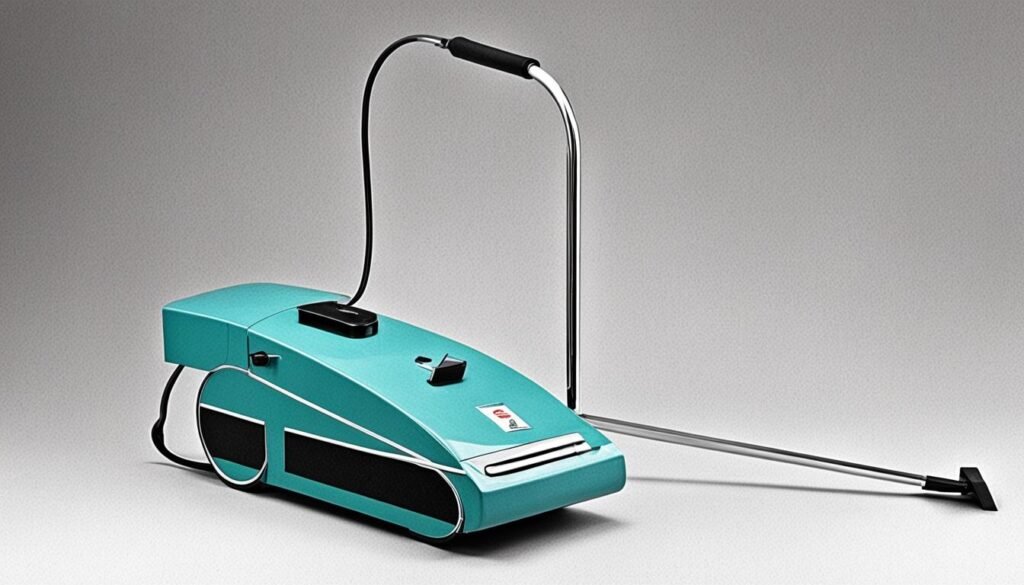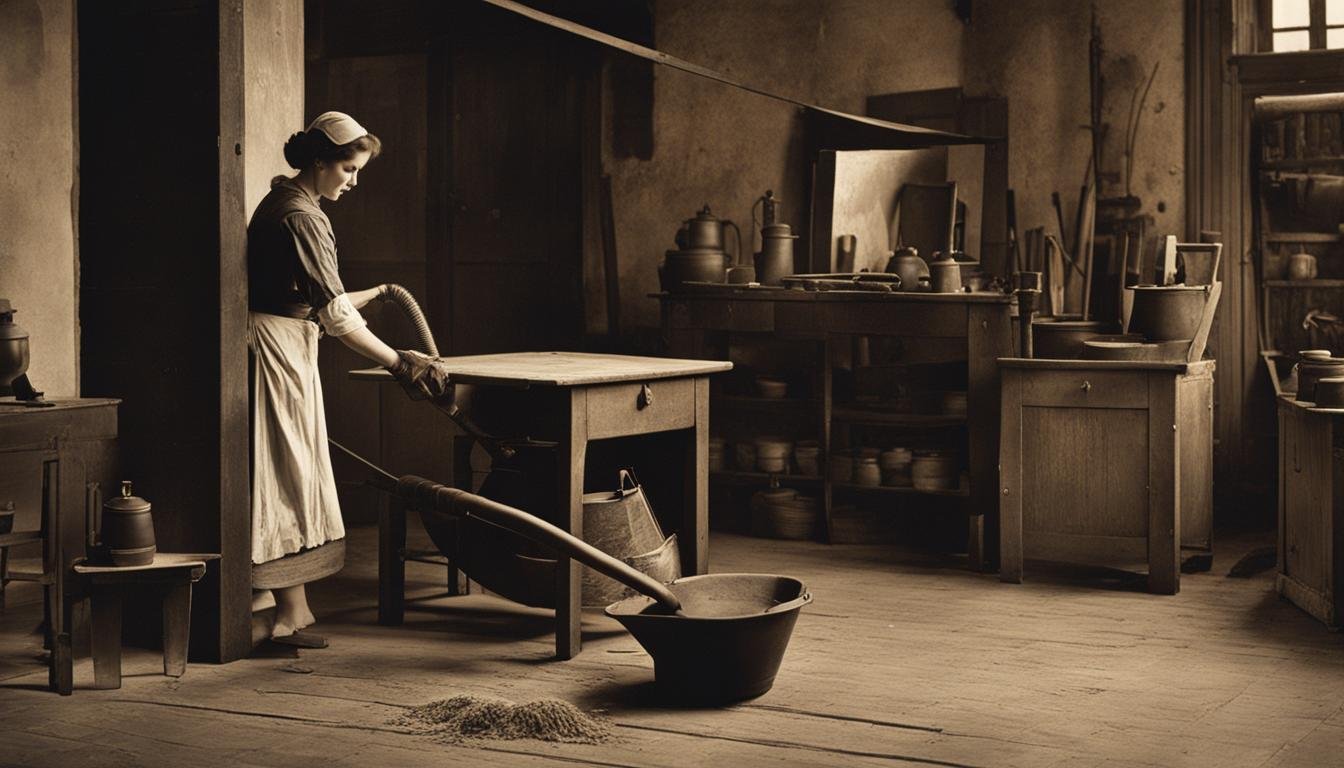Have you ever wondered about the origins of your trusty vacuum cleaner? Well, let me take you on a journey through the fascinating history and evolution of this essential household appliance.
In 1901, a brilliant engineer named Hubert Cecil Booth revolutionized the way we clean our homes by inventing the first vacuum cleaner. Booth’s invention, which sucked up dirt through a filter rather than blowing it out, was a game-changer. After rigorous testing and the establishment of the British Vacuum Cleaner Company, he introduced his groundbreaking machine to the streets of London.
The first vacuum cleaner, a large horse-drawn contraption, was a sight to behold. It made its way to the homes of the wealthy, including prestigious places like Buckingham Palace and the Royal Mint. As the popularity of vacuum cleaners soared, brands like Hoover and Electrolux led the way in making them smaller, more portable, and affordable for the average household.
Key Takeaways:
- The vacuum cleaner was invented by Hubert Cecil Booth in 1901.
- Booth’s machine used suction and a filter, ushering in a new era of cleaning technology.
- The first vacuum cleaner was a large, horse-drawn contraption that visited the homes of the wealthy.
- Brands like Hoover and Electrolux played a significant role in making vacuum cleaners more accessible and affordable.
- This invention transformed the way we clean our homes and paved the way for modern vacuum cleaner technology.
The Evolution of Vacuum Cleaners
The development of the vacuum cleaner did not stop with Hubert Cecil Booth’s invention. More inventors and engineers contributed to its evolution over the years. In the late 19th and early 20th centuries, manual vacuum cleaners and carpet sweepers were introduced. These early models used bellows or hand-cranked fans to create suction. In 1906, James B. Kirby invented the “Domestic Cyclone” vacuum cleaner, which used water for dirt separation. James Murray Spangler, a janitor, invented the first portable electric vacuum cleaner in 1907, which led to the establishment of the Hoover Company. Throughout the 20th century, vacuum cleaners continued to improve in size, efficiency, and design, with innovations such as beater bars, disposal filter bags, and upright models. Today, vacuum cleaners come in various types, from handheld and cordless variants to robotic cleaners that can navigate autonomously.

Early Vacuum Cleaning Devices
In the late 19th and early 20th centuries, several inventors introduced novel vacuum cleaning devices that laid the foundation for modern vacuum cleaner technology. Among them were manual vacuum cleaners and carpet sweepers.
“Manual vacuum cleaners and carpet sweepers played a crucial role in the early days of vacuum cleaner development. These devices relied on mechanical principles to create suction for picking up dirt and debris.”
One such model was the Manual Electric Vacuum Cleaner, patented in 1869 by Ives W. McGaffey. It featured a hand-cranked fan that created suction to draw in dirt and dust. Other manual vacuum cleaners used bellows or foot-powered mechanisms for suction.
Water Separation and Electric Innovation
As vacuum cleaner technology progressed, new innovations emerged. In 1906, James B. Kirby introduced the “Domestic Cyclone” vacuum cleaner, which used water for dirt separation. The device passed air through water, trapping the dirt and dust particles.
“James B. Kirby’s ‘Domestic Cyclone’ vacuum cleaner revolutionized cleaning by utilizing water for filtration. This invention paved the way for more efficient dust separation mechanisms in vacuum cleaners.”
Another significant milestone came in 1907 when Janitor James Murray Spangler invented the first portable electric vacuum cleaner. He designed the machine to alleviate his asthma symptoms and sold the patent to William Henry Hoover. This invention served as the foundation for the Hoover Company’s success in the vacuum cleaner market.
Advancements in Size, Efficiency, and Design
Throughout the 20th century, vacuum cleaners continued to undergo improvements in various aspects. Innovations such as beater bars, disposal filter bags, and upright designs made vacuuming more effective and convenient.
“Innovations such as beater bars, disposal filter bags, and upright designs transformed the efficiency and usability of vacuum cleaners, enabling users to achieve cleaner homes more easily.”
The introduction of beater bars enhanced the cleaning efficiency of vacuum cleaners by dislodging dirt and debris from carpets and upholstery. The disposable filter bags made it easier to collect and dispose of captured dirt and dust without releasing them back into the environment. Upright vacuum cleaners, like the Hoover Model 150 introduced in 1926, offered greater maneuverability and ease of use.
Evolution of Vacuum Cleaners
| Year | Key Milestone |
|---|---|
| 1869 | Patent for Manual Electric Vacuum Cleaner by Ives McGaffey |
| 1906 | James B. Kirby invents the “Domestic Cyclone” vacuum cleaner |
| 1907 | James Murray Spangler invents the first portable electric vacuum cleaner |
| 1926 | Introduction of Hoover Model 150, an upright vacuum cleaner |
As the years passed, vacuum cleaners continued to evolve, adapting to changing consumer needs and technological advancements. Today, vacuum cleaners have become an essential tool for maintaining cleanliness in homes and offices.
The Future of Vacuum Cleaners
With advancements in technology, the future of vacuum cleaners looks promising. Smart appliances, including robotic vacuum cleaners, have gained popularity in recent years. These devices can navigate and clean autonomously, making household chores more convenient.
Additionally, innovations like self-cleaning windows and ovens are being developed. The introduction of robotics and artificial intelligence into vacuum cleaner design opens up possibilities for even more advanced features and capabilities.
However, despite these technological advancements, the time spent on household chores remains relatively unchanged. Factors such as hygiene standards and the increased responsibilities of pet and child care contribute to the continued need for efficient cleaning solutions. Only time will tell how vacuum cleaners will continue to evolve and shape the future of cleaning technology.
FAQ
How was the vacuum cleaner invented?
The vacuum cleaner was invented in 1901 by engineer Hubert Cecil Booth. He developed a machine that sucked up dirt through a filter instead of blowing it out.
Who invented the first vacuum cleaner?
The first vacuum cleaner was invented by Hubert Cecil Booth.
What were the early vacuum cleaning devices like?
Early vacuum cleaning devices included manual vacuum cleaners and carpet sweepers that used bellows or hand-cranked fans to create suction. In 1906, James B. Kirby invented the “Domestic Cyclone” vacuum cleaner, which used water for dirt separation.
When was the first portable electric vacuum cleaner invented?
The first portable electric vacuum cleaner was invented in 1907 by James Murray Spangler, a janitor. This invention led to the establishment of the Hoover Company.
How have vacuum cleaners evolved over the years?
Vacuum cleaners have evolved in terms of size, efficiency, and design. Innovations such as beater bars, disposal filter bags, and upright models have improved their effectiveness.
What is the future of vacuum cleaners?
The future of vacuum cleaners looks promising with the emergence of smart appliances, including robotic vacuum cleaners. These devices can navigate and clean autonomously, making household chores more convenient.





Leave a Reply